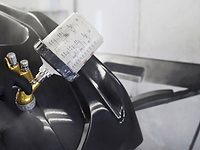Case Study: Quality Defects Eliminated, Productivity Tripled

Image courtesy of Steen-Hansen.

Bio-fouling after 140 days in an uncoated aquaculture net (right), and an aquaculture net with the copper-free coating (left). Images courtesy of Steen-Hansen.


ystral jetstream mixers perform mixing processes with a turbulent micro-mixing zone in the mixing head and almost turbulence-free macro-mixing of the entire vessel contents. Image courtesy of ystral.

ystral double tank system at Steen-Hansen consisting of two process vessels incorporating jetstream mixers, a powder vessel, and the Conti-TDS inline disperser. Image courtesy of Steen-Hansen.





Steen-Hansen has been a leading provider of anti-fouling coatings for nets in industrial fish farming for more than 30 years. Anti-fouling coatings reduce the growth of algae and other organisms on the nets, meaning they can be used for longer periods of time. In addition to conventional copper-based anti-fouling coatings, copper-reduced—not to mention completely copper-free and biocide-free coatings—are becoming increasingly important in the fish farming industry. Steen-Hansen is a pioneer in the development and manufacture of coating solutions like these with a reduced environmental footprint.
Innovative Coatings Call for New Process Technology
The company initially used dissolvers, which it also used for its copper-based coatings, to make these innovative anti-fouling coatings. However, the company found that using conventional production techniques for copper-reduced or copper-free coatings resulted in quality deficiencies, since the long process times in the dissolver caused strong, undesirable foaming in the product.
Several factors were responsible for this foaming. On the one hand, powders contain a great deal of air. Even heavy powders such as titanium dioxide contain more than 75% air by volume. If this air is not fully substituted by liquid and separated, but rather dispersed together with the powder particles, this creates micro-foam, which is exactly what happens in a dissolver process. Additionally, the fact that—in a dissolver—the powder is added to the open vessel from above leads to the creation of vortexes, which introduce large amounts of additional air. Since Steen-Hansen’s products are water-based, another factor is the process water foaming, regardless of the technology used.
The company managed to counteract this undesirable foaming by using defoamers, but only to a certain extent. This is why it was looking for a way to disperse the powdered raw materials in a gentler, more product-friendly way, ultimately opting for the technology offered by mixing and dispersion technology specialist ystral. “ystral’s process engineering solution allowed us to overcome the quality problems and, at the same time, significantly shorten our production times,” reported Stig Bjarte Fagerlid, Plant Manager at Steen-Hansen AS.
In the ystral process system installed in 2019, the intense process steps of powder wetting and dispersion take place outside the vessel with the Conti-TDS in-line powder-wetting and dispersing machine, while the contents of the vessel are simultaneously mixed in a continuously homogeneous manner with a jetstream mixer.
Using the vacuum expansion method, the inline disperser achieves complete deagglomeration and wetting of the powder particles in a matter of microseconds. Due to an induction vacuum built up directly in the wetting and dispersing zone, the air contained in the powder is expanded many times over, enormously increasing the distances between the particles and allowing the particles to be completely wetted immediately, one by one, on contact with the liquid. The air contained in the powder is separated from the significantly heavier dispersion through the centrifugal effect of the fast-running rotor and coalesces to large air bubbles.
These are then pumped to the process vessel with the liquid flow, where they can easily escape. There are no vortexes and there is no additional air intake during the entire process. This can help to significantly reduce the use of defoamers.
All Production Now Aligned with this Technology
Based on this experience, the company decided to install two more ystral process systems while modernizing and expanding its production capacities. “We completely reorganized our production facilities as part of a relocation, and aligned our entire production infrastructure with ystral technologies,” commented Fagerlid. “ystral technologies allow us to fully automate our production processes. But, at our old site, we were unable to exploit this potential. So we used the move as an opportunity to comprehensively automate the peripheral devices of the ystral systems with powder and liquid handling.”
Whereas, at the old production site, the operators still opened bags manually and poured their contents into the system’s powder hopper, now all the powder materials are fed from the silo to the ystral systems by means of a fully automatic chain conveyor.
At its new site, Steen-Hansen uses one system each for producing anti-fouling coatings containing copper, for making copper-free coatings, and for manufacturing industrial paints. A system consists of two process vessels with the ystral’s jetstream mixers, a powder vessel, and the company’s in-line disperser, which is operated alternately on one of the two process vessels. While powder and liquid handling at the company is performed using a central control system, each system is fed from separate silos and tanks. This eliminates the possibility of the copper-free coating products being contaminated with copper particles, for example.
Fully Automatic Production
The Control System Professional +, the ystral control system with the highest degree of automation, is used as the control software for the three systems. The operator starts and monitors the process using a graphical user interface, and dosing and feeding of the liquid components and solids is fully automatic. Every single process step is exactly reproducible, and creating new recipes is child’s play with the recipe handler.
By using modern mixing and dispersing technology, and centrally controlled peripheral devices with automated feeding and dosing of powder and liquid components, Steen-Hansen successfully tripled its production capacity at its new site, all the while keeping its staff levels the same. The three ystral systems can be operated by just one employee. With the dissolvers previously used, the process often lasted one to two hours, but this was shortened to between 10-15 minutes with the new technology. While Steen-Hansen was barely able to meet the rapidly growing demand for its products with the production infrastructure it used previously, even in a two-shift operation, it has now switched to a one-shift operation in the new factory.
The significantly shorter process time also goes hand in hand with a considerable reduction in energy consumption, which is particularly important to the Norwegian producer , since electricity prices are high in Norway. Measured in terms of electricity demand per litre of finished product, Steen-Hansen cut its electricity demand at the new site by about 75% simply by using more efficient mixing and dispersing technology, and energy-saving building technology.
For more information, click here.
Looking for a reprint of this article?
From high-res PDFs to custom plaques, order your copy today!












